Progressions to build your full-court man defense
The full-court, defensive slide zigzag drill is a program staple. It works on proper defensive ready positions, drop-step footwork, slides, and hand and body location.
Here are some suggested progression to get even more out of the zigzag drill and build up your full-court man defense.
Defensive slides (no offense)

On the coach’s whistle, each player slaps the floor with two hands and shouts “defense!” The defensive players then take two big steps to the right by pointing their lead foot in the direction of the slide and moving it as they push off with their back feet.
Once at the edge of their third of the court, each player performs a good drop/swing step by planting and pushing off with their lead foot, swinging their trailing elbow in the direction they are going next, rotating their hips open and reaching with their new lead foot in a big step while staying low. The players then take two big steps to their left and perform another drop/swing step. This process is repeated until the opposite baseline is reached.
During the defensive slide and drop-step process, each defender traces an imaginary ball with their lead hand in the direction the player is sliding, taking away the passing lane while the other hand is low taking away the crossover dribble. Coaches should make sure both hands are in proper position on the slides and switch to the correct positions on each drop/swing step.
The coach can start the next group as soon as the previous group passes the nearest foul line. This drill provides a good introduction to players new to the configuration.
Defensive slides (no hands)
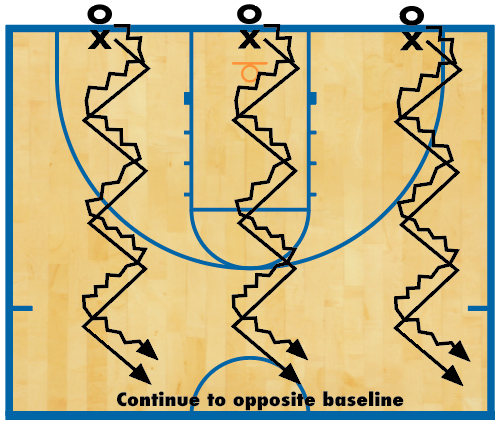
DIAGRAM 2: The next progression is to add offense. We take away the use of the defense’s hands to emphasize moving their feet as fast as they can and to avoid reaching. To do this, we give each defender a towel or tell them to interlock their hands, place them behind their necks and pull themselves down into a low defensive stance. The towel or interlocked hands work to get the player low like you would want in a game. It also adds some grit and toughness to the drill.
The offense is instructed to go at 75-percent speed in a zigzag pattern. It’s important to coach offense as well, ensuring each ball handler has knees bent, dribbles with the shoulder over the ball and below the knee, has the protect hand up, and makes quick, long and low crossovers.
Now that there is an offensive player, additional instruction is provided to the defender. They must work hard to stay ahead of the offensive player, beat them to their spot and turn them. The defender is instructed to be an arm’s length away with the head up on the ball, which places the defender’s lead foot one step ahead of the ball-handler’s lead foot, while the defender’s trailing foot splits the ball handler’s legs.
We divide each of the three lanes of the court by “smalls,” “mediums” and “bigs.” Be sure the same players aren’t matched up all the time.
Defensive slides (traditional)
The second progression frees the defender’s hands. We repeat the drill as previously shown with the defensive player going against a ball-handler, but now slap the floor and shout “defense!” in unison again before each pair goes. We focus on the handwork previously discussed.
Defensive slides (pick up the dribble)
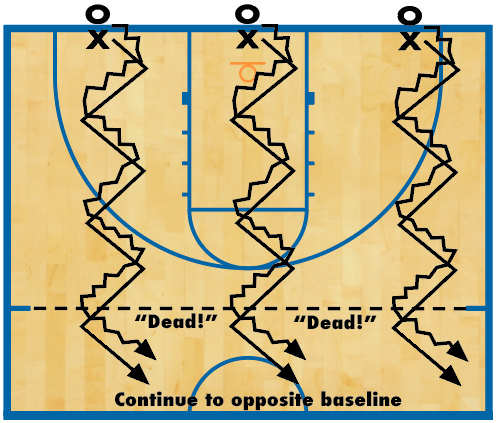
DIAGRAM 3: The third progression teaches what to do when the ball handler picks up their dribble. The configuration and drill is performed as before, but this time we have the ball handler pick up the dribble at the first volleyball line. The defender is instructed to shout “dead!” five times, “close the gap” and trace the ball with both hands. It’s important to shout “dead!” five times to intimidate and panic the ball handler, and to let the other defenders know to get into a hard deny position looking to intercept a poor pass.
After the ball handler counts off two to three seconds, he or she is told to reverse pivot. At this point, the defender must close the gap even further, straddling the ball handler’s pivot foot between their legs and “chest up” ball handler. We are looking for the ball handler to move their pivot and get a traveling violation.
Once the ball handler counts six seconds, they resume dribbling and the pair continues to zigzag to the next volleyball line, where the pick-up-the-dribble action is repeated. After another six seconds, the players continue to the baseline.
Defensive slides (sideline influence)
In the fourth progression, we teach the importance of keeping the ball-handler on one side of the court once they enter into the front court. This creates a ball/strong side and a help/weak side for our defense. We do this by running the drill as before, but instructing the defense to keep the ball handler on the right side of their lane once the pair reaches the half-court line.
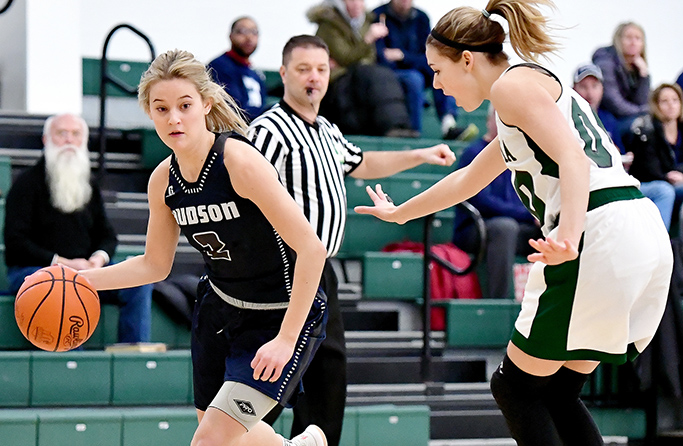
The defender needs to put their right foot forward in a staggered boxer’s stance to force and keep the ball handler on the right side of their lane. The defender has to be careful not to get beat up the sideline and not get beat back to the middle, as the emphasis is to keep the offensive player on the sideline.
Remind the defender to use the big-step technique to cutoff the sideline if the offense is about to get by. They should do the same to keep the offensive player from going to the middle. The defender must continually jab and juke at the ball handler with attack and retreat steps to stay in control and force the side.
Repeat the drill, this time with the defender forcing the ball handler to the left side of their lane.
Full court 1-on-1
The fifth progression opens it all up. Use the same three-lane configuration, but this time the ball handler is instructed to beat the defender using any combination of dribble moves that they are comfortable with. We only give the defender one rule: Don’t get beat.
The concept of “intelligent pressure” comes into play, staying low the whole possession and moving the feet by working hard. We want to be one arm’s length away from the ball handler, but we tell the defender to keep the ball handler in front of them.
If the defender gets beat, we tell them to pick a spot about 5 feet ahead of the ball handler, sprint to that spot, get back into their stance and re-establish control. Siding the ball handler in catch-up mode does no good. If we notice a defender get beat and not put max effort into sprinting ahead and re-establishing control, we blow the whistle and everyone does one pushup. The punishment increases with multiple violations.
Full court 2-on-2

DIAGRAM 4: Next, we add in an inbounder and an inbound defender. The team is divided into three groups of four. Within each group, two players are on offense and two on defense.
Be sure to mix the guards and “bigs” evenly through the groups and lineup as shown. The action starts when the coach hands the ball to the inbounder and begins a five-second count. The inbound defender shouts “dead!” multiple times and jumps up and down, doing everything they can to force a violation or deflect the inbound pass.
The cutter defender (X1) plays behind the cutter (1). Once the cutter receives the ball, X1 shouts “I got ball!” and plays up with “intelligent pressure” about an arm’s length away. X1 looks to zigzag the ball handler up the court using attack, retreat, and drop/swing steps. They must stay low, move their feet quickly, stay a half-step ahead of the ball and turn the ball handler. X1 jabs at the ball but does not reach or grab. They are looking to force a 5-second closely guarded count, an unforced error, a deflection or a steal.
» ALSO SEE: Learning the 2-2-1 full-court zone press
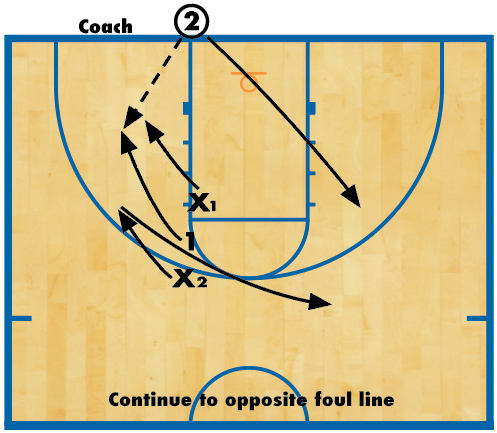
At minimum, the defender makes the trip downcourt very difficult. After the inbound pass is made, X2 sprints ahead of the ball to be in help position and prevent a pass to 2. We give the illusion of two defenders covering the ball. If X2 has to help and stop/take the ball, X1 sprints ahead to take X2’s man and gets into help position. And if 2 doesn’t clear the area with a hard sprint, X2 puts additional pressure on the ball handler by faking a trap, moving slightly towards 1, then quickly back into position on 2.
If 2 picks up the dribble, X1 shouts “dead!” and defends while X2 denies the pass. The defenders look to force a 5-second violation, get a deflection or get a steal. On a pass to 2, X1 sprints ahead of the ball to be in help position for X2 in case he or she gets beat and can’t recover. The offense advances the ball up the floor to the opposite foul line, then curls out off the court and jogs back the sideline to the original baseline. Switch offensive and defensive roles.
We also run the drill with the inbound defender playing behind the cutter, moving them into face-guard position (DIAGRAM 5). We call this configuration “centerfield,” and we are looking to get a steal on the inbounds pass by having the cutter face guarded while X2 takes away the lob.
Full court 3-on-3
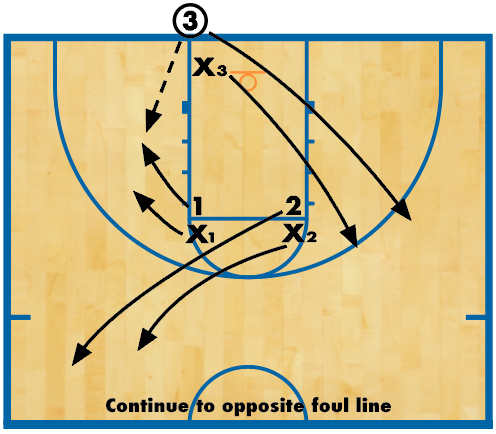
DIAGRAM 6: In our next-to-last progression, we add a second cutter. After the inbound pass, X2 and X3 sprint ahead of the ball to be in a help position for X1 in case they get beat and can’t recover. We also give the illusion of three defenders covering the ball.
If X2 or X3 have to help and stop/take the ball, X1 sprints ahead to take 2 or 3. If 2 or 3 do not clear the area or do so with a hard sprint, X2 or X3 puts additional pressure on the ball handler by moving slightly toward them before quickly getting back in to position. On a pass to 2 or 3, X1 sprints ahead of the ball to be in help-position for X2 or X3 in case they get beat and can’t recover. The offense advances the ball up the floor to the opposite foul line, then returns to the original baseline. They then switch roles.
As before, we run the drill in the centerfield configuration. The defenders on the cutters are instructed to switch all screens with a loud “switch” call. It’s also important to instruct the defender being screened to work hard and fast to get back on and under the screener to take away the reverse pivot and roll to the ball.
Full court 5-on-5
Lastly, we play 5-on-5. The two additional defensive players are positioned toward the ball and in help-position so that they can deny a hard cut by their men but are not out of position to defend the pass. The rest of the principles are the same as 3-on-3. We are giving the illusion of five defenders covering the ball.
We occasionally play up and back with the offense trying to score and simulating any defensive rebound as a score by having the rebounder outlet the ball to the coach. That sets up the inbound going back the other way as the offense quickly transitions into the full-court press.









